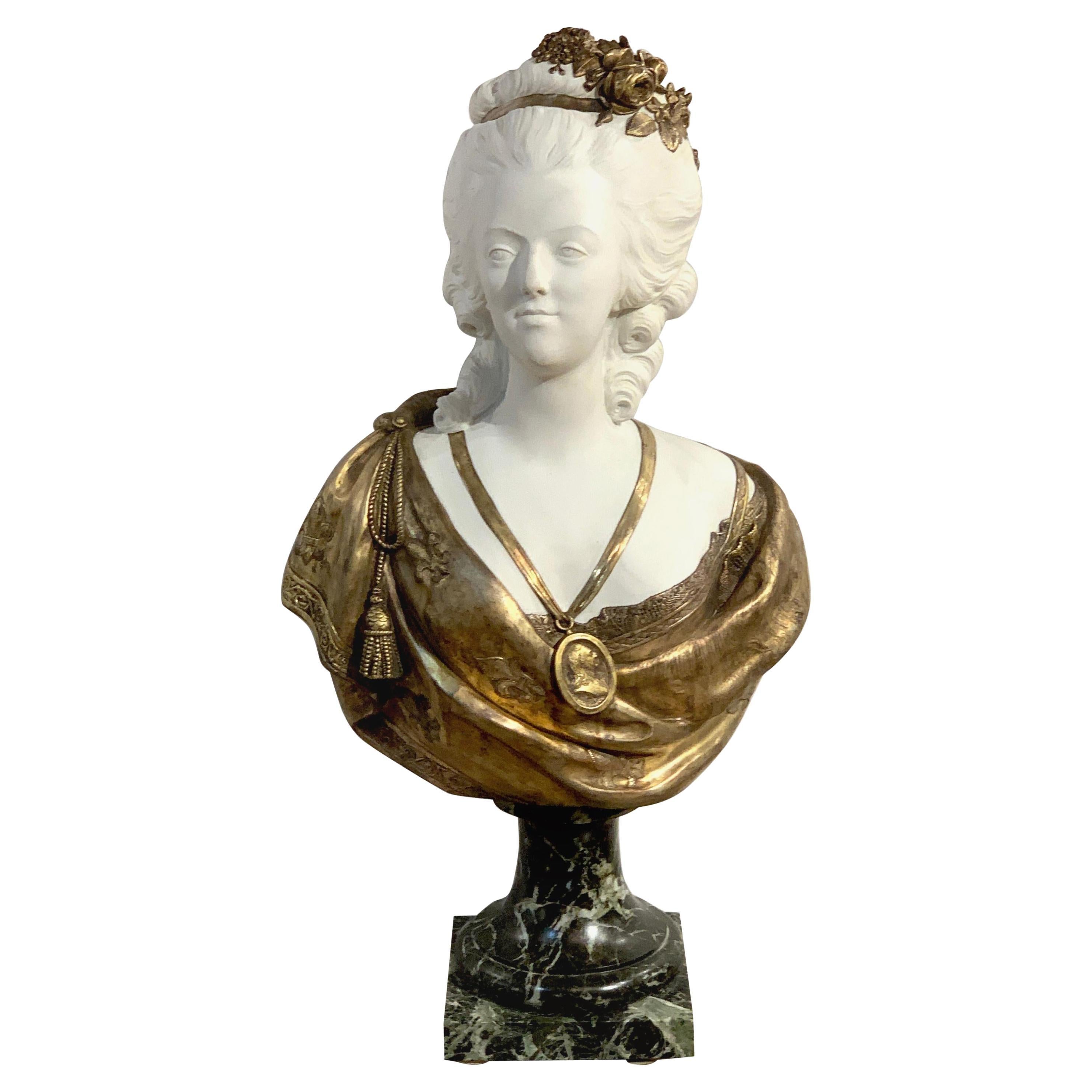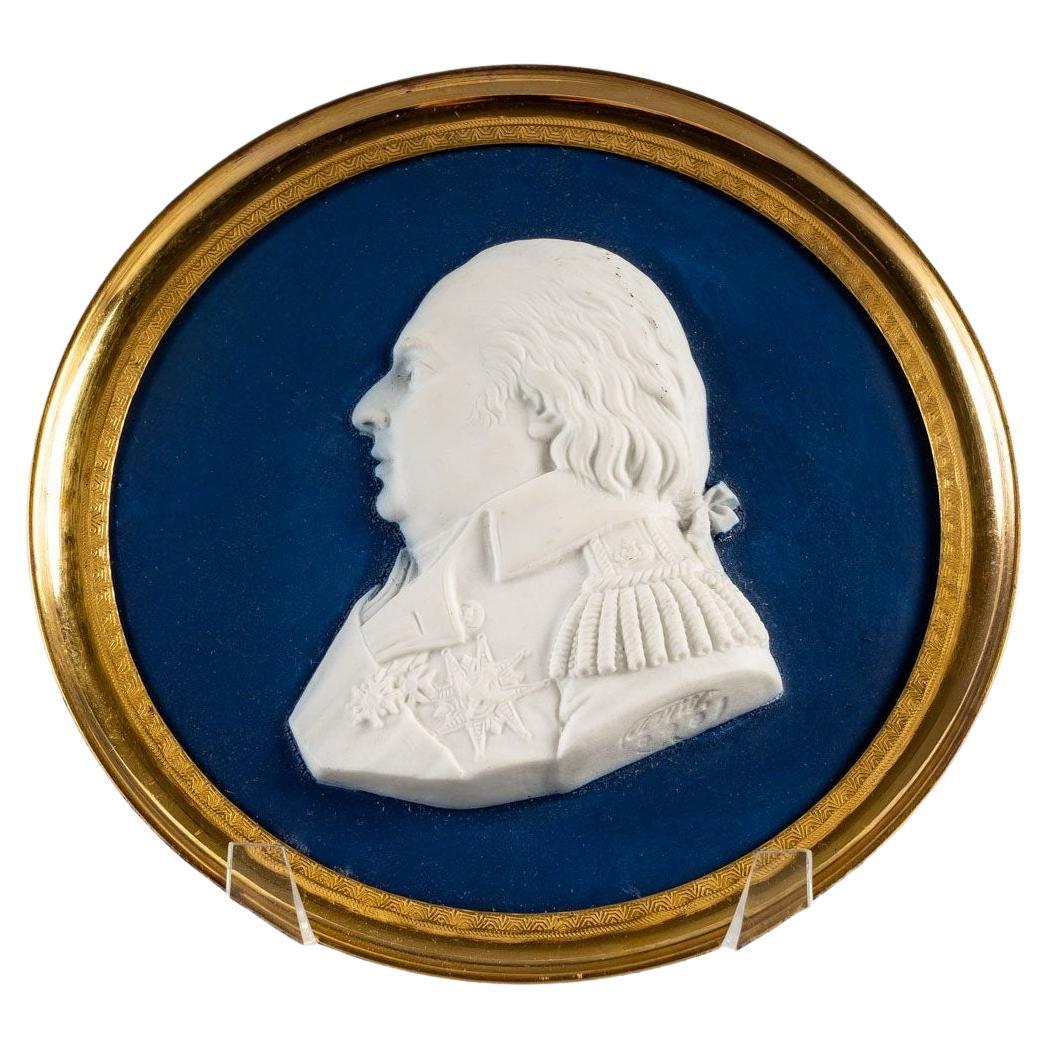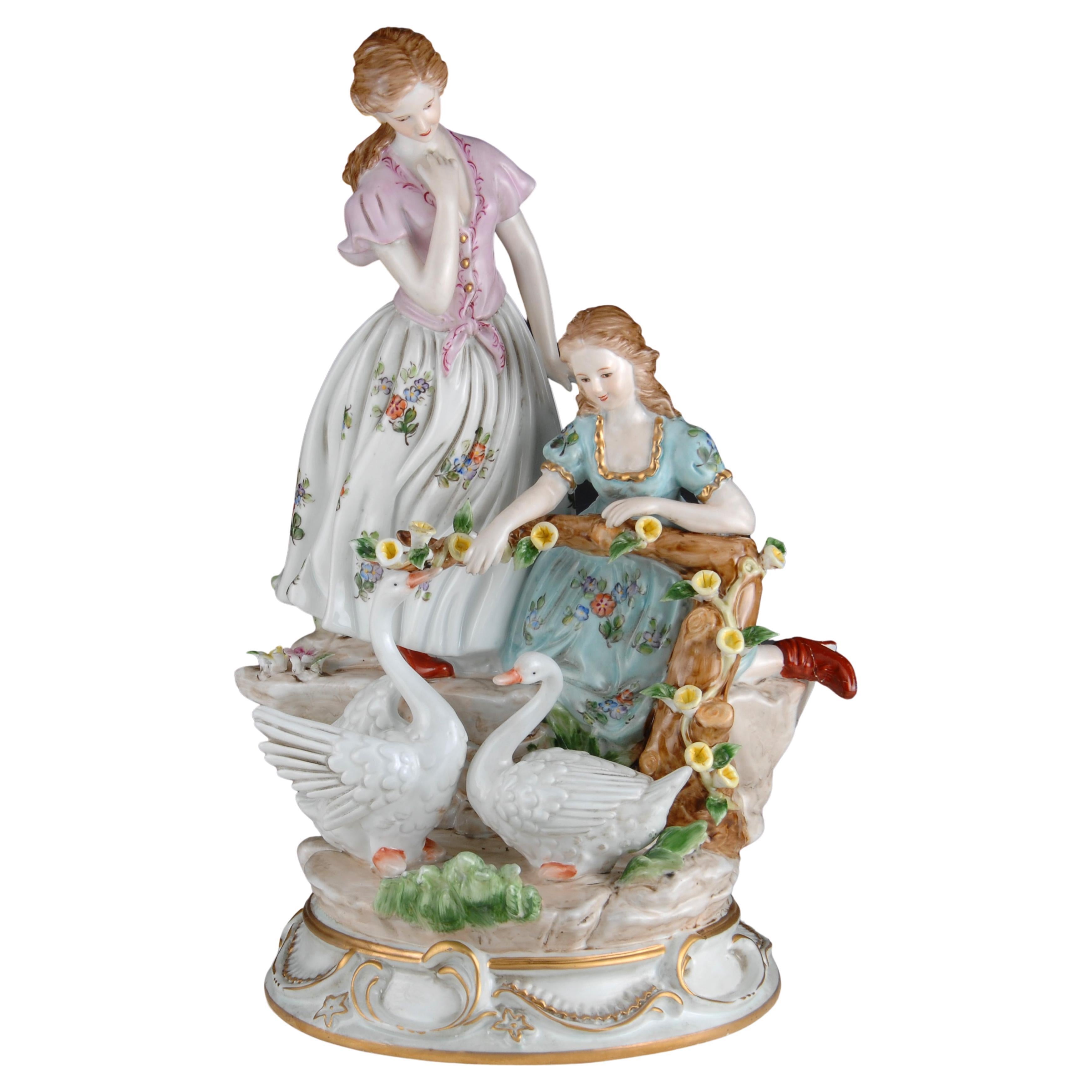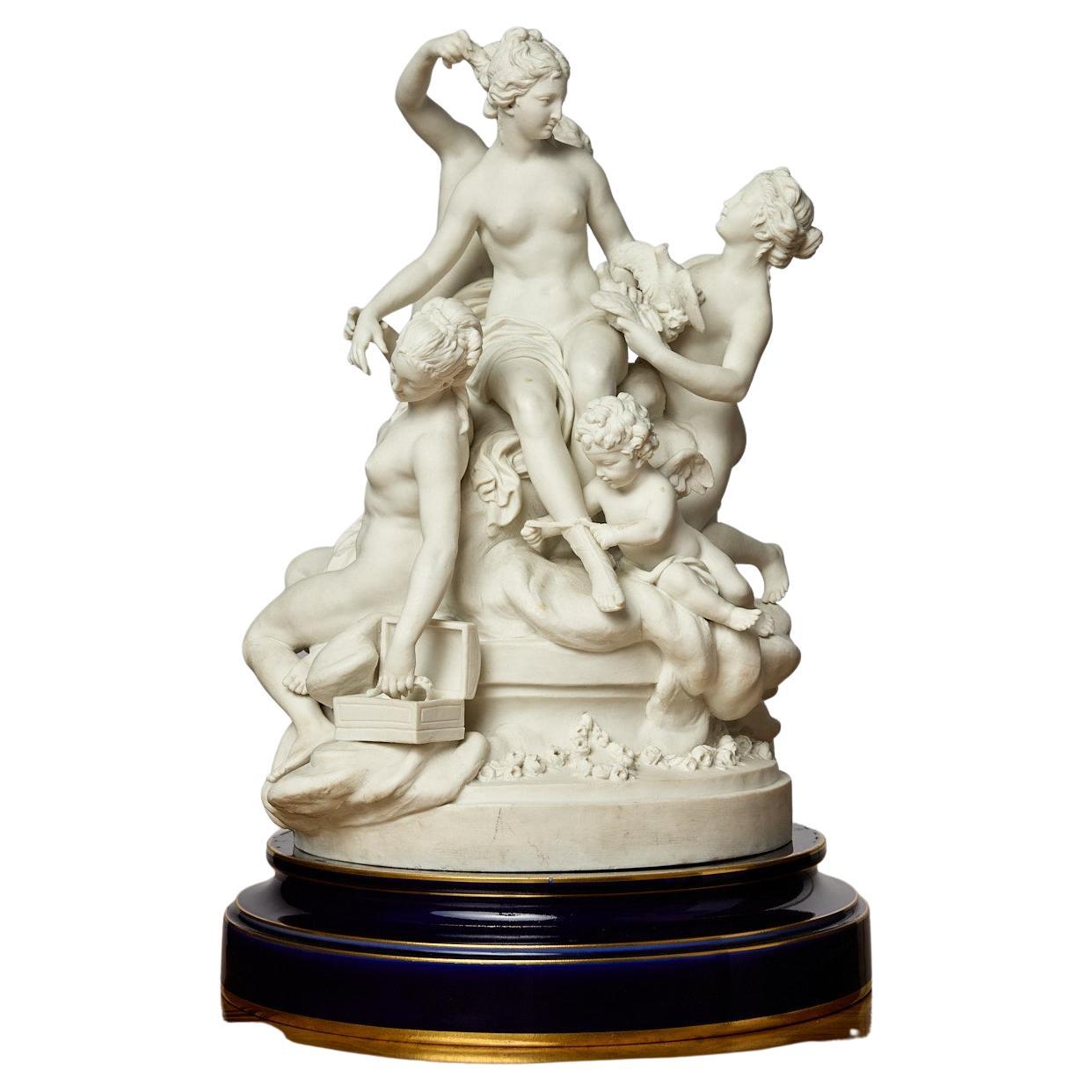French Sevres Biscuit Porcelain Figure of a Nude "Le Repos" After Alfred Boucher
About the Item
- Creator:Manufacture Nationale de Sèvres (Manufacturer)
- Dimensions:Height: 11.5 in (29.21 cm)Width: 33.13 in (84.16 cm)Depth: 13 in (33.02 cm)
- Style:Rococo (In the Style Of)
- Materials and Techniques:
- Place of Origin:
- Period:1910-1919
- Date of Manufacture:circa 1911
- Condition:Repaired: It appears to have some old touch-up/restoration to the legs thigh, but no visible damage. Wear consistent with age and use. Minor fading. A truly beautiful and sensual sculpture. Overall current condition is very good, all the fingers and toes are intact. It appears to have some old touch-up/restoration to the legs thigh, but no visible damage. A great coffee table conversation piece.
- Seller Location:Los Angeles, CA
- Reference Number:
Manufacture Nationale de Sèvres
A maker of exemplary European ceramics for hundreds of years, Manufacture Nationale de Sèvres has produced porcelain of the highest quality since 1740.
The factory enjoyed royal patronage from its earliest days, and its most prominent patrons in the late 1700s — King Louis XV of France and his mistress, Madame de Pompadour — commissioned some of the period’s most elegant and striking pieces (only the truly wealthy could afford porcelain at this time). The company was originally established in Vincennes but was moved at the request of Madame de Pompadour, in 1756, to Sèvres, near Versailles, so that its operations would be closer to her château.
Sèvres became a mighty and much-revered factory working under a special grant from King Louis XV — the company’s owner as of 1759 and whose abundance of orders for special state gifts put financial strain on the company. Madame de Pompadour is said to have commissioned Sèvres to create an entire indoor garden of porcelain botanicals, for example.
While Sèvres gained a sterling reputation for its soft-paste porcelain wares, the company was late in entering into the production of hard-paste porcelain.
Hard-paste porcelain is the most common type of Chinese porcelain, then a widely exported and profitable product that was not made in Europe until the 18th century. The resources at Sèvres were largely relegated to meeting the demands of Louis XV, and secondly, it did not acquire the secret formula for hard-paste porcelain until 1761. Until it obtained the coveted secrets behind hard-paste porcelain from a chemist named Pierre-Antoine Hannong — and, years later, gained access to the elusive raw materials to make hard-paste porcelain — Sèvres produced soft-paste porcelain for decades that was widely celebrated but is comparatively a far weaker type as opposed to the hard-paste productions of the company’s rival, Meissen, in Saxony, the first to produce true porcelain outside of Asia.
The artisans at Sèvres applied the rarest and most difficult-to-produce colors to their decorative objects and dinner services. One such color, the bright bleu de roi, became the manufacturer’s signature shade and is found on many of their objects. Sèvres also experimented with rarely glazed or unglazed works that bore no decoration at all — bisque porcelain, French for “biscuit,” refers to unadorned white porcelain sculptures made at Sèvres that resemble white marble after being kiln-fired.
Sèvres marks were applied over the glaze or rendered with cuts by a sharp tool — authentic Sèvres porcelain is most commonly marked with two interlaced Ls that are painted in blue and enclose a third letter. Painters and potters were tasked with affixing marks to record their role in the creation of a particular piece, and as a lot of these artisans’ names are recorded in archival factory materials — and there is also much to be learned at the Sèvres museum — it’s likely that you can accurately identify your Sèvres piece.
Find antique and vintage Manufacture Nationale de Sèvres vases, urns, sculptures and more on 1stDibs.
- ShippingRetrieving quote...Ships From: Los Angeles, CA
- Return PolicyThis item cannot be returned.
- French 19th Century Bronze Military Figure of "Blandan" after Jean GautherinBy Jean GautherinLocated in Los Angeles, CAA very fine French 19th century patinated bronze figure of the French hero of the Algerian conquest, Jean-Pierre Hippolyte Blandan (1819-1842) after the French Sculptor Jean Gautheri...Category
Antique 19th Century French Louis Philippe Figurative Sculptures
MaterialsBronze
- Fine French 19th Century Bronze Figure of "Milo of Croton & Lion" After FalconetBy Étienne Maurice FalconetLocated in Los Angeles, CAA very fine French 19th century Patinated bronze Figure of "Milo of Croton and the Lion" after the marble sculpture of Milon de Crotone by renown French...Category
Antique 19th Century French Baroque Figurative Sculptures
MaterialsMarble, Bronze
- Large French 19th Century Cast-Iron Fountain Figure of a Seated Nude MaidenBy J.J. Ducel Me de Forges 1Located in Los Angeles, CAA Fine and Large French 19th Century Cast-Iron Fountain Figure Modeled as a Nude Maiden Seated on a Rocky Outcrop Holding a Cornucopia in Her Raised Right Hand, by J.J Ducel. Cast-Signed "J.J. DUCEL Me de FORGES, PARIS". Circa: Paris, 1880. A retailer of fine cast-iron ornaments, J. J. Ducel was recorded as supplying cast-iron works through Paris as early as 1810 in the Pas-de-Calais. The factory was sold in 1878 to the Fonderie de la Haute-Marne and all of the firm's models were subsequently bought by the Val d'Osne foundry. However, prior to the firm's sale, critics at the 1867 Paris Exposition Universelle proclaimed that "Ducel is the great manufacturer of works in cast-iron, to whom Paris is so largely indebted for the grace and elegance that supply so many of the adornments of its streets". Ducel, Val d'Osne and other associated foundries produced both bronze and cast-iron statuary. Cast-iron is corrosive, whereas non-ferrous bronze does not suffer the same detrimental effects of weathering and is therefore a superior and more expensive material. Height: 51 1/2 inches (130.8 cm) Width: 22 inches (55.9 cm) Depth: 30 inches (76.2 cm) The foundry of Val d'Osne became highly regarded for the varied nature and quality of its castings in the second half of the 19th century. Commonly known after 1870 as simply Val D'Osne, the company was originally founded by J.P.V. André in Val d'Osne 1835 and developed rapidly, absorbing smaller foundries in the Haute-Marne area east of Paris. The foundry contributed to the London International Exhibition of 1851, where a bronze fountain cast with classical figures attracted much attention. André also specialised in fancy castings and architectural fittings. His Paris adress was at 14 Rue Neuve, Menilmontant. In 1855 the Barbezat & Cie Foundry was born out of the André workshop. In 1867 Barbezat & Cie changed its name to Houille & Cie. Then, in 1870, it changed its name to Société Anonyme du Val d'Osne. With the change of name came the change of casting mark and adress: Fonderies d'Art du Val d'Osne, 58 Bd Voltaire, Paris or simply Val d'Osne. Cast-iron had been in production during the 18th century but its inferior status to the more fashionable and delicate wrought-iron had generally confined its use to architectural work. By the early 19th century, however, rapid developments of the Industrial Revolution combined with the simultaneous burgeoning of a new middle class provided the impetus for a dramatic expansion in its application and in a short space of time a proliferation of iron foundries across Europe and America thrived on the production of everything from inkstands to railway stations. The use of cast-iron for garden ornament became particularly widespread at this time, as the possibilities for its mass-production at a fraction of the cost of bronze made it the material of choice for indoor/outdoor statuary...Category
Antique 19th Century French Classical Greek Figurative Sculptures
MaterialsIron
- French Early 20th Century Art Deco Marble Figure "Kneeling Nude Girl"By Affortunato GoryLocated in Los Angeles, CAA fine French early 20th century Art Deco white marble figure of a kneeling nude beauty, attributed to Affortunato Gory (Gori) (Italian, 1895-1925). The kneeling nude figure of a you...Category
Antique Early 1900s French Art Deco Figurative Sculptures
MaterialsCarrara Marble
- After Jean Louis Grégoire Spelter Figure "Boy Playing Pipe"By Jean Louis GrégoireLocated in Los Angeles, CAAfter Jean Louis Grégoire (France, 1840-1890) A Charming French 19th-20th Century Patinated Spelter Figure of "The Animal Charmer", depicting a sta...Category
Antique Early 1900s French Folk Art Figurative Sculptures
MaterialsMarble, Spelter
- Pietro Bazzanti a Carved Marble Figure Semi-Nude Young Bather GirlBy Pietro BazzantiLocated in Los Angeles, CAPietro Bazzanti - Barzanti (Italian, 1825-1895) "After the Bath" - a very Fine and large carved white Carrara marble figure of a semi-nude young maiden standing by the sea-shore. The smiling and posing young beauty, with bare breasts and back, her right arm juxtaposed over her head, while holding a blanket over her waist with her left hand and standing barefoot by a rocky seawall and wavy shoreline. Signed 'P. Barzanti/Florence' (on reverse) and raised on a cylindrical swiveling carved verde antico solid marble pedestal. circa: Florence, 1880-1890. Pietro Bazzanti or Barzanti (Italian, 1825-1895) was a 19th Century Italian sculptor born in Florence. Together with his brother, Niccolò Bazzanti (Firenze, 1802-1869) who was also a sculptor, they both worked the sprawling Florentine studio 'Pietro Bazzanti e Figlio' a hugely successful sculpture studio, operated within the family at their gallery on Lungarno Corsini until the mid-twentieth century. The studio was a place where many talented professors and apprentice sculptors specialized in sculpting marble...Category
Antique Late 19th Century Italian Greco Roman Figurative Sculptures
MaterialsMarble, Carrara Marble
- Sèvres Biscuit Porcelain and Ormolu Bust of Marie Antoinette after F. LecomteBy Manufacture Nationale de SèvresLocated in West Palm Beach, FLSèvres (Attributed) biscuit porcelain and ormolu bust of Marie Antoinette after Felix Lecomte (French sculptor 1737-1817) exquisitely cast and modeled, the face in white biscuit porc...Category
Antique Late 19th Century French Louis XVI Busts
MaterialsMarble, Ormolu
- Medallion of the King of France Louis XVIII, in Sèvres BiscuitBy Manufacture Nationale de SèvresLocated in Saint-Ouen, FR"Medallion of the king of France Louis XVIII, in sèvres biscuit". Beautiful Medallion of Louis XVIII in sèvres biscuit and gilded brass, restoration ...Category
Antique 19th Century French Restauration Busts
MaterialsBrass
- Porcelain Figure Group of Venus and Muses Samson 19th Century, Sevres FrenchBy Manufacture Nationale de SèvresLocated in Lantau, HKPorcelain figure group of Venus coronation and muses Samson after the style of Sevres, hand painted pastel colors, beautifully detailed artwork 19th century, French Marked Sevres Di...Category
Antique 19th Century French Figurative Sculptures
MaterialsPorcelain
- Early 19th Century Biscuit Bust of Louise Brongniart After Houdon Made by SèvresBy Manufacture Nationale de Sèvres, Jean-Antoine HoudonLocated in Casteren, Noord-BrabantLovely biscuit porcelain bust of a young girl, named Louise Brongniart. The bust is marked on the back with 'Houdon' and the Sevres mark. Biscuit por...Category
Antique Early 1900s French Belle Époque Busts
MaterialsPorcelain
- Ladies with Swans, Porcelain, After Models from SèvresBy Manufacture Nationale de SèvresLocated in Madrid, ESFigurine in enameled porcelain. "Two young people with swans". Inspired by models from the Manufacture Nationale de Sèvres (France). The two swans are placed at a lower level than ...Category
20th Century European Other Figurative Sculptures
MaterialsOther
- Sevres Bisque Porcelain, Toilet of Venus figural group, after BoizotLocated in Toronto, CAThis is a stunning bisque fired porcelain figural group depicting the Toilet of Venus in the Louis XVI style. The sculpture was originally modelled by ...Category
20th Century French Louis XVI Figurative Sculptures
MaterialsPorcelain






